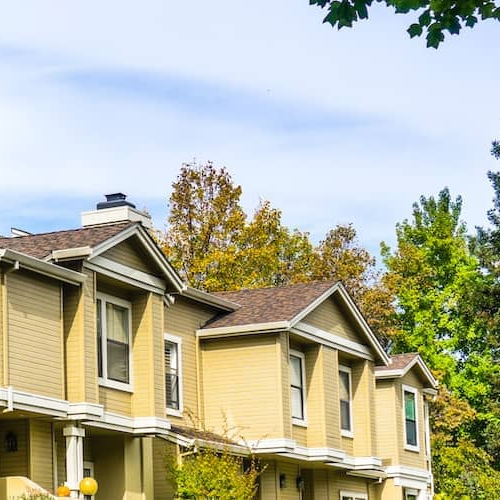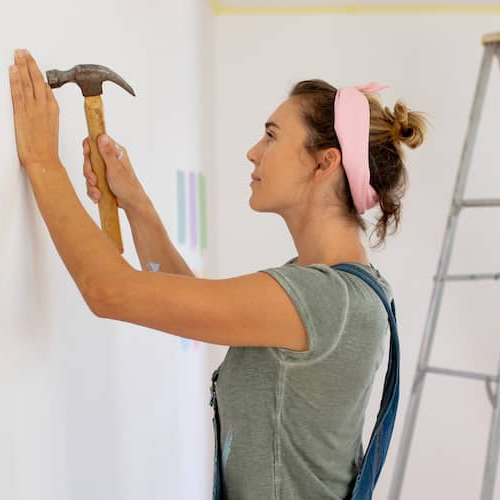Everything you should know about financing a modular home
Apr 25, 2024
•6-minute read
At every step of the process, building a home is challenging — from securing financing to hiring a builder to picking finishes to closing on the home. The potential hassle may be enough to deter people from buying a brand-new house. However, modular homes can be a happy middle ground between new and accessibility. If you’re considering a modular home, here are the basic things you need to know.
What is a modular home?
Modular homes are customized, prefabricated homes built offsite in a climate-controlled factory. After prefabrication is complete, individual sections (called modules) are then transported to the property. Once the modules arrive at the building site, the house is assembled on a permanent foundation. It’s very likely that you won’t be able to tell the difference between a modular home and a traditional house.
Since they are built on a permanent foundation, modular homes are permanently affixed as real property. That means you can benefit from financing it just as you would a traditional mortgage.
Modular vs. manufactured homes
There are major distinctions between modular homes and manufactured homes. Both are under the umbrella of prefabricated homes, but that’s about the only commonality between the two.
Manufactured homes were widely referred to as mobile homes before 1976. As mobile homes increased in popularity as a viable housing option, the U.S. Department of Housing and Urban Development (HUD) established new regulations via the Federal Manufactured Home Construction and Safety Standards Code. Since the introduction of these codes, mobile homes are referred to as manufactured homes and they are the only federally regulated type of home construction on the market. However, the terms “mobile” and “manufactured” are still used interchangeably.
Unlike modular homes, most manufactured homes can’t be financed with a traditional mortgage. Most lenders will only finance “real property” meaning that the home must be affixed to a foundation, tying the value of the home to the land’s value. Otherwise, the value of the mobile home depreciates like cars. However, people who want the option to move their home at a later date can get a mobile home loan.
How much does a modular home cost?
On average, a modular home costs $50 - $100 per square foot according to data from HomeAdvisor by Angi. This equates to a typical range of $180,000 – $360,000 total for a modular home.
That said, it’s hard to put an average overall price on modular homes because they can vary widely in size and price. You may opt for a tiny home under 400 square feet or build a 2,500-square-foot home. Additionally, there are numerous upgrades you can make to a modular home that will also increase the price, such as building a deck, adding a garage, installing a fence and building a basement.
You’re not just paying for the base home itself. Often, you’ll need to buy land before installing the prefab home. If that land isn’t primed for a house, you may need to spend more money leveling and removing trees from the property. Then you’ll need to connect utilities and pay for the installation itself. Still, it may be a more affordable option than a traditional home.
How to finance a modular home
How you finance a modular home depends on whether you’re building it or buying an existing home.
To build a modular home
If you’re building a modular home, you’ll need a construction loan and a land loan if the property hasn’t already been acquired. Be aware that construction loans typically require higher down payments. As a reminder, Rocket Mortgage® doesn’t offer these types of loans. However, once the house is built, you’ll need to convert your loan to a permanent loan, which we do offer.
To buy a modular home
Buying a modular home that’s already been constructed is just like buying a stick-built home. You’ll go through an initial mortgage approval process so that you know how much you can offer, providing things like W-2s, tax returns, pay stubs and bank statements.
Types of home loans for modular homes
When it comes to modular home financing, several loan options could help you finalize the funding you need. These include:
- FHA loans: The Federal Housing Administration (FHA) loan program offers mortgages for modular homes. Generally, you’ll need to put down at least 3.5% on a modular home that’s affixed to a foundation.
- USDA loans: For homebuyers in rural areas with qualifying income levels, USDA loans available through the U.S. Department of Agriculture might be an option. In some cases, you might not have to make a down payment on this loan type, which may cover both the home and the necessary land.
- VA loans: For home buyers with a qualifying military connection, VA loans offer an opportunity to buy a modular home with as little as 0% down.
Modular home loan requirements
As you navigate the modular home purchase process, expect to face the following loan requirements:
- Credit score: Although lenders often prefer to work with borrowers who have good credit, many lenders are willing to work with prospective modular home buyers who don’t have a good credit score. For example, the USDA doesn’t set a minimum credit score requirement.
- Down payment: Making a 20% down payment isn’t necessary to purchase a home. In fact, some loan programs don’t require a down payment of any kind.
- Sufficient income: You’ll need to have enough income to support the loan payments.
- Debt-to-income (DTI) ratio: Most lenders impose a maximum DTI ratio. Usually, your DTI cannot exceed 43%, but this ratio might be higher under certain circumstances. If your DTI is too high, work on paying down other debts before purchasing a home.
Pros and cons of modular homes
Whether you’re debating manufactured versus modular homes or are simply considering a more sustainable option than a stick-built house, there’s plenty to consider before taking the plunge.
Advantages of modular housing
Here are some of the pros of owning a modular home:
- Sustainable construction: One of the largest benefits of modular construction is reduced waste. Because companies can order supplies in bulk to a single location, the environmental impact of transporting small batches of varying materials for an on-site build is lessened.
- Affordability: Arguably the most compelling perk of modular homeownership is the bang for your buck. While they are virtually indiscernible from stick-built homes, they are considerably cheaper to build.
- Earlier move-in date: A modular home can be constructed in weeks rather than months or years compared to an on-site construction.
- Traditional mortgage options: Lenders appraise modular homes the same way they do on-site builds. That means you can expect the same competitive interest rates, insurance premiums, taxes and loan options as traditional houses. All the standard options are available, including conventional loans, FHA loans and VA loans.
- Customizations: Manufacturers often have various floor plans available for you to mix and match to meet your specific needs. The interior can be designed however you like – rustic, modern, log cabin and so on.
- Energy efficiency: Modular homes are often constructed to be more energy efficient than their stick-built counterparts. You’ll feel the effects when your monthly utility bill arrives. Plus, their highly customizable nature allows you to opt for home solar panels and other energy-efficient options.
Disadvantages of modular housing
Modular homes aren’t for everyone. If the following considerations are giving you pause, one may not be the right fit for you.
- Land: Since modular homes are immovable, it doesn’t make sense to build on rented land. If you’re building a modular home from scratch, you’ll need to buy and prepare land before you can install your home.
- Upfront costs: While a manufactured home owner could just rent land with no upfront costs, you’ll need to prepare to spend more upfront. Preparing the land alone may cost $4,000 – $11,000 between surveying and excavation work if it’s undeveloped land.
- Zoning restrictions: As popular modular homes might be, they make up a small percentage of homes in the U.S. Many cities either have outdated or an absence of zoning laws, which can make finding appropriate land difficult.
- Construction loan: You’ll likely need a construction loan to afford the manufacturing of your new home. Those may require a 20% – 25% down payment and can be converted to a permanent mortgage after construction. Rocket Mortgage doesn’t do construction loans, but we can help you with permanent financing.
FAQs about modular homes
Still undecided if a modular home is right for you? Here are some answers to the most frequently asked questions to help you learn more.
What’s the difference between a modular home and a traditional home?
Traditional homes are built completely onsite. On the other hand, modular homes are partially constructed in a factory and then transported and assembled on a permanent foundation on the owner’s land.
What is another name for a modular home?
The terms “modular home,” “manufactured home” and “mobile home” are sometimes used interchangeably, but there are important distinctions among them. Modular homes are held to the same building codes that stick-built homes are, and they are assembled on a permanent foundation. Manufactured homes, known as mobile homes before 1976, comply with federal HUD codes and can be moved.
Do modular homes appreciate in value?
Modular homes tend to appreciate in value similarly to the way traditional, stick-built homes do. This means the value of modular homes can also decrease with fluctuations in the real estate market.
The bottom line
A modular home’s parts are made in a factory before being put together on-site. It’s much faster and can be more cost-effective than a traditional stick-built home. At the same time, the financing options are similar to traditional homes, and you can get a standard mortgage.
If you would like, you can start a mortgage application online or give us a call at (833) 326-6018.
Kevin Graham
Kevin Graham is a Senior Writer for Rocket. He specializes in mortgage qualification, economics and personal finance topics. Kevin has passed the MLO SAFE exam given to mortgage bankers and takes continuing education courses. As someone with cerebral palsy spastic quadriplegia that requires the use of a wheelchair, he also takes on articles around modifying your home for physical challenges and smart home tech. He has a BA in Journalism from Oakland University.
Related resources

5-minute read
What is a multifamily home and is it right for you?
A multifamily home is a residential property with more than one housing unit. Learn everything about the ins and outs of multifamily real estate investments....
Read more
6-minute read
Kit homes: What you should know before buying
Kit homes are mail-order homes delivered in parts and built right on your property. Explore the pros and cons of building one and how much it could cost you.
Read more

7-minute read
Cheapest ways to build a house: 12 tips for affordable home building
Building a home can be a viable option for buyers in a competitive market, but expenses can add up quickly. Discover the cheapest ways to build a house.
Read more